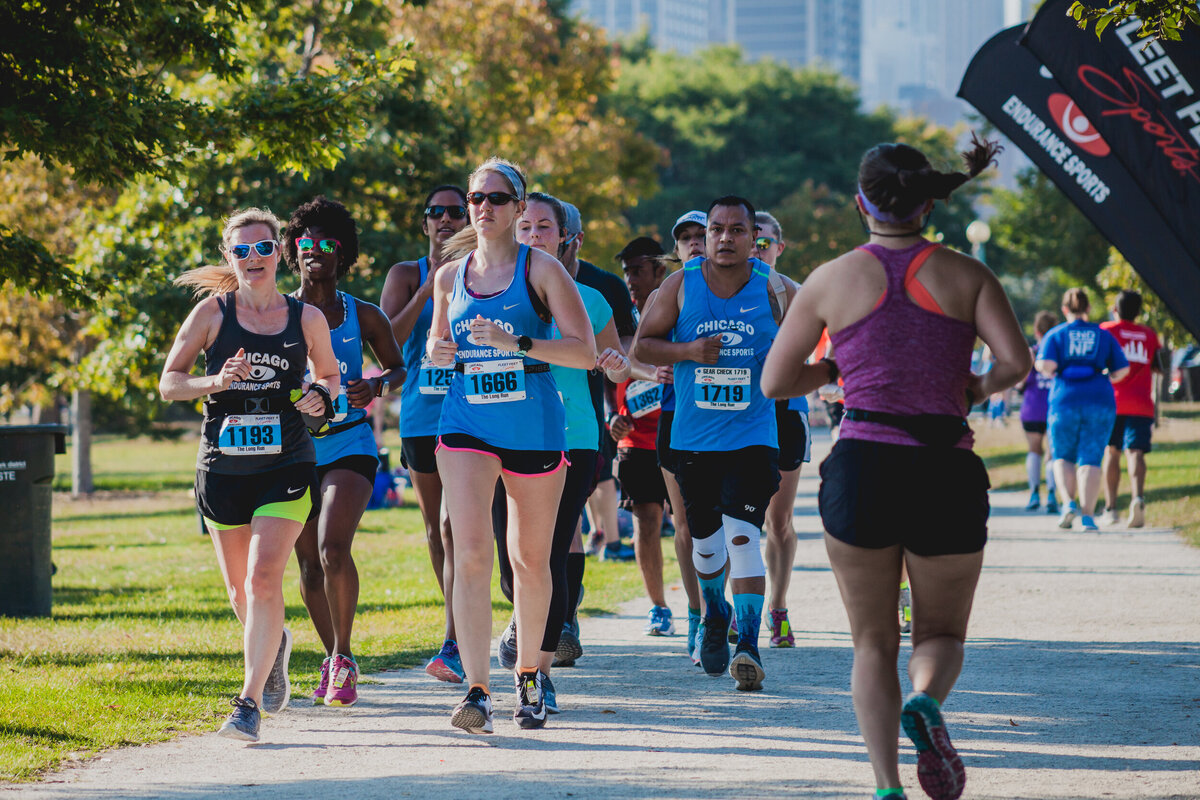Home>Misc>Featured>What Distance Running 3 Miles Outside Of Track


Featured
What Distance Running 3 Miles Outside Of Track
Modified: January 22, 2024
Discover the benefits of featured distance running 3 miles outside of the track. Improve your endurance and explore new terrain while staying fit and active.
Introduction
Distance running, also known as endurance running, is an exhilarating and fulfilling form of exercise that offers numerous physical, mental, and emotional benefits. Unlike running on a track or treadmill, running outside allows you to connect with nature, enjoy fresh air, and experience the changing scenery. Whether you’re a seasoned athlete or a beginner looking to embark on a new fitness journey, distance running can be a fantastic way to challenge yourself and achieve your health and wellness goals.
One of the primary advantages of distance running is its ability to improve cardiovascular fitness. Regular running helps strengthen the heart, increase lung capacity, and enhance blood circulation throughout the body. This can reduce the risk of heart disease, lower blood pressure, and improve overall cardiovascular health.
In addition to the physical benefits, distance running can have a positive impact on mental and emotional well-being. Running releases endorphins, also known as “feel-good” hormones, which can elevate mood, reduce stress, and combat symptoms of anxiety and depression. It provides an opportunity to clear the mind, alleviate tension, and promote mental clarity. Running outdoors, in particular, allows you to immerse yourself in nature, creating a serene and peaceful environment that further enhances the psychological benefits.
When it comes to choosing the right location for outdoor running, the possibilities are endless. You can explore urban areas, parks, trails, or even run along the coastline. The key is to find a location that inspires and motivates you, and offers a safe and enjoyable environment to run in. Consider factors such as terrain, accessibility, and the presence of other runners or pedestrians.
Before hitting the pavement, it’s important to adequately prepare for outdoor running. This includes investing in a good pair of running shoes that provide proper support and cushioning, as well as wearing comfortable and breathable clothing suitable for the weather conditions. It’s also crucial to warm up your body and stretch your muscles to prevent injury and improve performance. A dynamic warm-up routine that includes jogging, high knees, lunges, and leg swings can help prepare your body for the demands of distance running.
Proper running technique is another essential aspect of outdoor running. This involves maintaining good posture, engaging core muscles, and finding a stride that feels natural and efficient. It’s important to avoid overstriding or landing with a heavy heel strike, as this can put unnecessary stress on the joints and lead to injuries. Focus on landing mid-foot and maintaining a consistent cadence throughout your run.
Safety should always be a top priority when running outside. Make sure to stay alert and aware of your surroundings, especially when running in busy areas or during low-light conditions. It’s advisable to wear reflective clothing or accessories and carry a form of identification in case of emergency. Inform someone about your running route and estimated time of return, and consider running with a buddy or in well-populated areas for added security.
Benefits of Distance Running
Distance running offers a multitude of benefits for the mind, body, and soul. Whether you’re training for a marathon or simply seeking to improve your overall fitness level, incorporating regular distance running into your routine can have a transformative impact on your well-being.
One of the most noticeable benefits of distance running is weight management and calorie burning. Running is a highly effective form of cardiovascular exercise that helps to burn a significant amount of calories. When performed at a moderate pace, running can help you maintain a healthy weight or aid in weight loss by creating a calorie deficit. Additionally, this type of exercise can boost your metabolism, even after you’ve finished your run, which can help you burn more calories throughout the day.
In addition to its impact on weight management, distance running can improve overall cardiovascular health. Running strengthens the heart muscle, helping it pump blood more efficiently throughout the body. Regular running can reduce the risk of heart disease, lower blood pressure, and improve blood cholesterol levels. It can also increase the production of red blood cells, enhancing oxygen delivery to the muscles and improving endurance.
Aside from the physical benefits, distance running can also have a profound effect on mental health. Running releases endorphins, which are natural mood lifters and can help reduce symptoms of stress and anxiety. Engaging in regular running can enhance mental clarity, boost self-esteem, and promote a positive outlook on life. It provides an outlet for stress and tension, allowing you to clear your mind and promote a sense of well-being.
Distance running can also have a positive impact on bone health. Running is a weight-bearing exercise that places stress on the bones, stimulating bone growth and preventing the loss of bone density. This can help reduce the risk of osteoporosis and improve overall bone strength and structural integrity.
Another benefit of distance running is its ability to improve muscle tone and strength. Running engages a variety of muscle groups, including the quads, hamstrings, calves, and glutes. Over time, this can lead to leaner, more defined muscles and improved overall strength. Additionally, running helps strengthen the core and promote better posture, which can be beneficial for overall body alignment and stability.
Lastly, distance running offers a sense of accomplishment and satisfaction. Setting goals and achieving them through running can boost self-confidence and provide a sense of pride and fulfillment. Whether it’s completing your first 5K, conquering a challenging trail run, or achieving a personal best in a marathon, distance running allows you to push your boundaries and discover the incredible capabilities of your own body.
Choosing the Right Location
When it comes to distance running, choosing the right location is key to ensuring an enjoyable and fulfilling experience. The location you select can greatly impact your motivation, safety, and overall running experience. Here are some factors to consider when choosing the right location for your outdoor runs.
Terrain: The terrain of the running location is an important consideration. Some runners prefer flat surfaces, while others enjoy the challenge of hilly or uneven terrain. Consider the level of difficulty you’re comfortable with and choose a location that matches your fitness level and goals.
Accessibility: It’s important to choose a location that is easily accessible and convenient for you. Look for running routes that are close to your home or workplace to minimize travel time and make it easier to incorporate running into your daily routine.
Scenery: Running in a beautiful and visually appealing environment can make your runs more enjoyable and motivate you to keep going. Look for locations that offer scenic views, such as parks, trails, or waterfront areas. This can make your runs more enjoyable and provide a respite from the monotony of running on the same route every day.
Safety: Your safety should always be a top priority when choosing a running location. Look for well-lit areas, especially if you plan to run during early morning or late evening hours. Avoid isolated or secluded areas and opt for routes that are well-populated and frequented by other runners or pedestrians. If running in a park or trail, familiarize yourself with the park hours and any specific safety precautions you should take.
Facilities: Consider whether the running location has amenities such as water fountains, public restrooms, or nearby parking facilities. These can be useful for staying hydrated during your run and making it more convenient for you to begin and end your workout.
Variety: Running on the same route every day can get monotonous and hinder your motivation. Look for locations that offer a variety of running paths or trails. This can provide a refreshing change of scenery and keep your runs interesting and engaging.
Community: Consider whether the running location has a strong running community or group. Running with others can provide motivation, support, and camaraderie. Look for locations that have organized running events, running clubs, or social media groups where you can connect with fellow runners.
By considering these factors and finding the right running location, you can create an environment that aligns with your goals, keeps you motivated, and adds an element of joy and adventure to your distance running journey.
Preparing for Outdoor Running
Preparing for outdoor running is essential to ensure a safe and successful workout. Whether you’re a beginner or an experienced runner, taking the time to properly prepare can help prevent injuries, improve performance, and enhance your overall running experience. Here are some important steps to take before hitting the pavement.
Invest in Proper Gear: One of the first steps in preparing for outdoor running is investing in proper gear. Start with a good pair of running shoes that provide adequate support and cushioning. Visit a specialty running store to get fitted for the right shoes based on your foot type and running style. Additionally, wear comfortable, moisture-wicking clothing that is suitable for the weather conditions.
Prepare for the Weather: Pay attention to the weather forecast before heading out for your run. Dress appropriately for the temperature and consider layering your clothing so you can adjust as needed during your run. In hot weather, wear lightweight, breathable clothing and consider wearing a hat or visor and using sunscreen. In cold weather, layer up with moisture-wicking and insulating clothing, and protect your extremities with gloves and a hat.
Warm-up and Stretch: Proper warm-up and stretching exercises are crucial to prepare your body for running. Begin with a dynamic warm-up routine, which can include exercises such as jogging in place, high knees, lunges, and leg swings. The goal is to increase your heart rate, warm up your muscles, and improve joint mobility. After your warm-up, spend a few minutes stretching your major muscle groups, focusing on your calves, quads, hamstrings, and hips.
Plan Your Route: Before heading out, plan your running route in advance. Decide on the distance and the direction you want to take. Consider factors such as traffic, pedestrian footfall, and safety of the area. If you’re unfamiliar with the route, use mobile apps or websites that offer pre-planned running routes, or ask fellow runners for recommendations.
Stay Hydrated: Proper hydration is essential for optimal performance and safety during outdoor running. Drink water before, during, and after your run to maintain proper hydration levels. Carry a water bottle with you or plan your route near water fountains or hydration stations. Adjust your fluid intake based on the duration and intensity of your run, as well as the weather conditions.
Set Realistic Goals: Before each run, set realistic goals for yourself. Determine the distance or time you want to achieve and pace yourself accordingly. Setting goals can help keep you motivated and focused during your run. It’s important to listen to your body and adjust your goals as needed, especially if you’re just starting out or coming back from an injury.
Vary Your Training: To avoid monotony and plateaus in your training, mix up your workouts. Include a combination of steady-state runs, interval training, hill sprints, and long-distance runs in your training plan to challenge your body and improve your fitness level. Varying your training will also help you avoid overuse injuries and keep your workouts interesting.
By taking the time to properly prepare for outdoor running, you can optimize your performance, reduce the risk of injury, and make the most out of your running experience. Remember to listen to your body, be consistent in your training, and enjoy the journey.
Warm-up and Stretching
Warm-up exercises and stretching are essential components of any outdoor running routine. They help prepare your body for the demands of running and reduce the risk of injuries. Incorporating a proper warm-up and stretching routine into your pre-run regimen can improve your performance, flexibility, and overall running experience. Here are some key points to keep in mind when warming up and stretching before a run.
Dynamic Warm-up: Start your warm-up with dynamic exercises that get your blood flowing and increase your heart rate. These exercises help raise your body temperature, loosen up your muscles, and improve joint mobility. You can include activities such as jogging in place, high knees, butt kicks, leg swings, and arm circles. Aim to perform these dynamic exercises for about 5-10 minutes to adequately warm up your body.
Stretching: After your dynamic warm-up, it’s important to perform static stretches to further prepare your muscles for the run. Static stretches involve holding a specific position for about 20-30 seconds without bouncing or jerking. Focus on stretching your major muscle groups, including your calves, quadriceps, hamstrings, and hips. You can include stretches such as calf stretches, quad stretches, hamstring stretches, and hip flexor stretches. It’s important to stretch both sides of your body evenly and avoid any pain or discomfort while stretching.
Benefits of Warm-up and Stretching: Warming up and stretching before a run offers several benefits. It increases blood flow to your muscles, which helps improve muscle flexibility and range of motion. This can enhance your running performance and reduce the risk of muscle strains, cramps, and other injuries. Additionally, stretching helps to relax your muscles and improve muscle symmetry, which can contribute to better running form and efficiency.
Focus on Problem Areas: Pay attention to any specific areas of your body that may need extra stretching or attention. For example, if you tend to experience tightness in your calves or hips, dedicate more time to stretching those areas. Personalize your stretching routine to address your individual needs and focus on areas that may be prone to tightness or discomfort during your runs.
Timing: It’s important to perform your warm-up and stretching routine immediately before your run. This ensures that your body remains warm and your muscles stay loose as you begin your run. Performing these exercises too far in advance may diminish their effectiveness. However, it’s worth noting that some researchers argue that dynamic stretching exercises should be done after the run, as they may negatively impact performance if done beforehand. Experiment with different approaches and find what works best for your body.
Listen to Your Body: Pay close attention to how your body feels during the warm-up and stretching process. It’s important not to rush through the exercises or push yourself beyond your limits. If you experience any pain or discomfort while stretching, ease off or modify the stretch to a more comfortable level. Your warm-up and stretching routine should feel invigorating, not painful.
By incorporating a thorough warm-up and stretching routine into your outdoor running regimen, you can improve your flexibility, reduce the risk of injuries, and enhance your overall running performance. Remember to be consistent with your warm-up and stretching practices, adapt them based on your body’s needs, and always listen to your body’s signals during this crucial pre-run routine.
Proper Running Technique
Proper running technique is crucial for maximizing efficiency, preventing injuries, and enhancing overall performance. By focusing on your running form and implementing correct posture and stride mechanics, you can optimize your stride and make your running experience more enjoyable and effective. Here are some key elements to consider when it comes to proper running technique:
Posture: Maintaining good posture while running is essential. Keep your head up and your gaze forward, rather than looking down at your feet. Relax your shoulders and avoid hunching or tensing them. Engage your core muscles to support your posture and maintain a neutral spine. Allow your arms to swing naturally at your sides, with a slight bend at the elbows.
Footstrike: Pay attention to your footstrike, which refers to how your foot lands on the ground with each step. Aim to land with a midfoot strike, where your foot makes contact with the ground under your body, rather than striking with your heel or landing on your toes. This helps to distribute the impact forces more evenly and reduces the risk of injury.
Cadence: Cadence refers to the number of steps you take per minute. Aim for a higher cadence, which means taking shorter and quicker steps. This increases efficiency and reduces the risk of overstriding, which can put stress on your joints. Aiming for a cadence of around 180 steps per minute is a good guideline to prevent overstriding.
Stride Length: The length of your stride is another important aspect of proper running technique. It’s important to avoid overstriding, where your foot lands too far in front of your body, as this can lead to a braking effect and increased risk of injury. Instead, focus on taking smooth, efficient strides that allow your foot to land underneath your body with each step.
Arm Swing: Proper arm swing can help maintain balance and enhance overall running efficiency. Your arms should swing naturally back and forth, parallel to your body. Avoid crossing your arms too far over your chest or allowing them to swing across your body. Aim for a relaxed arm swing that complements your stride and rhythm.
Breathing: Proper breathing technique is important to ensure your body gets sufficient oxygen during your run. Breathe deeply and rhythmically, inhaling through your nose and exhaling through your mouth. Find a breathing pattern that feels natural and comfortable for you, and try to maintain a steady and even breathing rhythm throughout your run.
Listen to Your Body: Remember to listen to your body as you focus on improving your running technique. Pay attention to any signs of pain, discomfort, or fatigue. Adjust your form or training approach as needed. Be mindful of your body’s limits and avoid pushing beyond what feels comfortable. Gradually implement any changes to your running technique to allow your body to adapt.
By incorporating proper running technique into your outdoor runs, you can reduce the risk of injuries, improve efficiency, and enhance your overall running experience. Take the time to focus on your posture, footstrike, cadence, stride length, arm swing, breathing, and listening to your body. With practice and consistency, you’ll develop a running technique that is both efficient and sustainable.
Safety Tips
When engaging in outdoor running, it’s crucial to prioritize safety to ensure a worry-free and enjoyable experience. By following these safety tips, you can minimize the risk of accidents, stay protected, and focus on achieving your running goals.
Be Aware of Your Surroundings: Stay alert and aware of your surroundings at all times while running. Keep an eye out for vehicles, cyclists, pedestrians, and potential hazards on the road or trail. Stay on designated running paths and sidewalks whenever possible.
Run in Well-Lit Areas: Opt for well-lit running routes, especially if you plan to run in the early morning or after sunset. Proper visibility increases your safety and reduces the chances of accidents or encounters with potential threats.
Wear Reflective Gear: Make yourself visible to others by wearing reflective clothing or accessories when running in low-light conditions. This will help drivers and cyclists see you more easily, reducing the risk of accidents.
Tell Someone Your Route: Inform a family member or friend about your running route and estimated time of return. This ensures that someone knows your whereabouts in case of any emergencies.
Carry Identification: Always carry identification with you, such as a driver’s license, identification card, or a wristband with your contact information. In case of an accident or medical emergency, this will help others provide you with the necessary assistance.
Run Against Traffic: When running on the road, always run against the flow of traffic. This allows you to see oncoming vehicles and react accordingly. Be cautious and mindful of drivers, and yield to them when necessary.
Run with a Buddy: Consider running with a friend or joining a running group. Running with a buddy not only provides added safety and security but also adds a social element to your runs.
Carry a Phone: Bring a fully charged mobile phone with you during your runs. In case of emergencies or if you need assistance, having a phone readily available can be a lifeline.
Stay Hydrated: Proper hydration is essential during outdoor running, especially in hot weather. Carry a water bottle or plan your route near hydration stations. Drink water before, during, and after your run to maintain fluid balance and prevent dehydration.
Know Your Limits: Listen to your body and know your limits. Push yourself, but do not overexert or overstrain. Gradually increase your distance or intensity to avoid injuries and burnout.
Trust Your Instincts: If something feels off or unsafe during your run, trust your instincts and take necessary precautions. Modify your route, seek help, or find a safer location to continue running.
Weather Considerations: Be aware of the weather conditions before heading out for your run. Dress appropriately, protect yourself from extreme temperatures, and avoid running during severe weather warnings or conditions that may pose a risk to your safety.
By following these safety tips, you can create a secure environment for your outdoor runs and focus on enjoying your time on the road or trail. Remember that safety should always be a top priority, so be proactive and take the necessary steps to protect yourself while running.
Hydration and Nutrition
Proper hydration and nutrition are vital for maintaining energy, optimizing performance, and promoting overall health and well-being during outdoor running. By following these guidelines, you can ensure that your body is adequately fueled and hydrated for a successful and enjoyable running experience.
Hydration: Hydration plays a critical role in maintaining optimal performance and preventing dehydration. Drink water regularly throughout the day, not just during your runs. As a general guideline, aim to consume around 8-10 glasses of water per day or more if you’re engaging in intense exercise or in hot weather conditions. During your runs, bring a water bottle with you or plan your route near water fountains or hydration stations. Sip water at regular intervals to stay hydrated and replenish fluid lost through sweating.
Nutrition: Fueling your body with the right nutrients is essential for providing energy and supporting endurance during your runs. Prioritize a balanced diet that includes a variety of fruits, vegetables, whole grains, lean proteins, and healthy fats. Before your run, consume a snack or meal that combines carbohydrates for energy and a small amount of protein for muscle repair and recovery. Examples include a banana with peanut butter, a Greek yogurt with berries, or a granola bar with nuts.
Pre-Run Fuel: In addition to your regular meals, consider fueling up with a small snack before your run, especially if you’re running for longer durations. Aim to consume a light snack containing carbohydrates about 30 minutes to an hour before your run. This can provide an immediate source of energy and prevent hunger during your run. Good options include a piece of fruit, a small handful of nuts, or a low-fiber energy bar.
During-Run Fuel: For longer runs, consider replenishing your energy levels with carbohydrates during your run. This can come in the form of energy gels, sports drinks, or easily digestible snacks such as energy bars or bananas. Experiment with different options during your training runs to determine what works best for you in terms of taste, digestion, and energy replenishment.
Post-Run Recovery: After your run, prioritize post-run recovery by consuming a combination of carbohydrates and protein within 30-60 minutes. This can help replenish glycogen stores, aid in muscle repair, and promote recovery. Good options include a protein shake, chocolate milk, or a meal that contains lean protein, whole grains, and vegetables.
Listen to Your Body: Every runner is unique, and individual hydration and nutritional needs may vary. It’s important to listen to your body and make adjustments accordingly. Pay attention to how your body responds to different foods, fluid intake, and timing. Stay mindful of any signs of dehydration, such as excessive thirst, dark urine, or dizziness, and make hydration a priority.
Consult a Professional: If you have specific dietary restrictions or concerns about your hydration and nutrition needs, consider consulting a sports dietitian or nutritionist. They can provide individualized guidance and recommendations based on your goals, training intensity, and personal health considerations.
By prioritizing hydration and nutrition, you can optimize your energy levels, improve performance, and enhance your running experience. Remember to stay hydrated throughout the day, fuel your body with a balanced diet, and adjust your nutrition strategies based on the duration and intensity of your runs. With proper hydration and nutrition, you’ll be well-equipped to conquer your running goals.
Setting Goals and Tracking Progress
Setting goals and tracking your progress are instrumental in maintaining motivation, measuring improvement, and staying on track with your outdoor running journey. By establishing clear goals and implementing effective tracking methods, you can push yourself, celebrate milestones, and continue to grow as a runner. Here are some key aspects to consider when it comes to setting goals and tracking your progress:
Define Your Goals: Start by defining your running goals. Whether you want to complete your first 5K race, improve your pace, or train for a marathon, having specific goals can provide direction and purpose to your training. Make sure your goals are realistic, measurable, and time-bound. Write them down and revisit them regularly to stay focused.
Break it Down: Breaking down your larger goals into smaller, manageable targets can make them more attainable. Set short-term and long-term objectives that build upon one another. For example, if your ultimate goal is to run a half marathon, you can set shorter-term goals such as running a 10K race or increasing your weekly mileage gradually.
Track Your Runs: Use technology or a running journal to track your runs. Many smartphone apps and GPS watches allow you to record distance, pace, and other metrics like heart rate. This data can help you analyze your progress and identify areas for improvement. Alternatively, you can keep a running journal where you manually log your runs, noting distance, time, and how you felt during each run.
Measure Performance: In addition to tracking your runs, measure your performance periodically to assess progress. This can include completing a timed run at a set distance to gauge improvements in speed, or running a specific route with known landmarks to monitor your endurance and compare your times over time. Tracking performance can be a motivating way to see tangible improvements and celebrate your achievements.
Celebrate Milestones: Celebrate your achievements along the way, no matter how small they may seem. Each milestone reached is a step forward in your running journey. Treat yourself to a small reward, share your accomplishments with others, or treat yourself to new running gear. Recognizing and celebrating milestones can help maintain motivation and boost confidence.
Make Adjustments: As you track your progress, evaluate your goals and make adjustments as needed. If you’re consistently surpassing your targets, consider setting more challenging goals. On the other hand, if you’re struggling to meet your goals, reassess and modify them to make them more realistic. Flexibility and adaptability are key to continued growth and success.
Seek Support and Accountability: Share your goals with others and seek support and accountability. Join a running group or find a running buddy who can provide encouragement and motivation. Consider participating in organized races or events that align with your goals, as they can provide a supportive environment and a sense of community.
Listen to Your Body: While setting goals and tracking progress is important, it’s crucial to listen to your body throughout the process. Pay attention to any signs of overexertion, fatigue, or injury. Be flexible with your training schedule, make necessary adjustments, and prioritize rest and recovery. Your overall well-being should always come first.
Setting goals and tracking progress create a roadmap for your outdoor running journey. They provide focus, motivation, and a sense of accomplishment. By breaking down your goals, tracking your runs, celebrating milestones, and adapting when needed, you can continue to challenge yourself and achieve new heights in your running journey.
Cooling Down and Recovery
As important as it is to warm up before a run, cooling down and prioritizing post-run recovery is equally crucial for your outdoor running routine. Properly cooling down and allowing your body to recover after a run can help prevent muscle soreness, reduce the risk of injury, and promote overall well-being. Here are some key aspects to consider when it comes to cooling down and recovery:
Cooling Down: After completing your run, take the time to cool down by gradually reducing your pace to a slower jog or walking. This allows your body to gradually transition from a state of exertion to a state of rest. Take at least 5-10 minutes to gradually slow down your heart rate and breathing.
Stretching: Once you’ve cooled down, incorporate stretching exercises to help release tension in your muscles and improve flexibility. Focus on stretching your major muscle groups, including your calves, quadriceps, hamstrings, and hips. Hold each stretch for 20-30 seconds and avoid bouncing or jerking movements. Stretching can help prevent muscle tightness and improve recovery.
Foam Rolling: Consider adding foam rolling to your post-run routine. Foam rolling, also known as self-myofascial release, involves using a foam roller to apply pressure to specific areas of your body to release tension and tightness in the muscles and connective tissues. It can help alleviate muscle soreness, increase flexibility, and aid in recovery. Spend a few minutes targeting specific areas of tightness or discomfort.
Compression: Wearing compression socks or sleeves after your run can aid in recovery by promoting blood circulation and reducing muscle inflammation and soreness. Compression garments can help minimize muscle damage and expedite the removal of metabolic waste products from your muscles.
Hydration and Nutrition: Proper hydration and nutrition after your run play a crucial role in recovery. Replenish your fluids by drinking water or a sports drink to restore electrolyte balance. Consume a balanced meal or snack within 30-60 minutes of your run to refuel your body with carbohydrates for energy and protein for muscle repair.
Rest and Active Recovery: Allow your body time to rest and recover in between runs. Rest days provide an opportunity for your muscles and joints to repair and rebuild. Engage in active recovery activities on rest days, such as gentle stretching, yoga, or low-impact cross-training exercises like swimming or cycling, to promote blood circulation and aid in recovery.
Sleep: Prioritize quality sleep as part of your recovery routine. Sleep plays a crucial role in muscle repair, hormone regulation, and overall recovery. Aim for 7-9 hours of uninterrupted sleep each night to allow your body to fully recover and rejuvenate.
Listen to Your Body: Pay close attention to how your body is responding to your runs and adjust your recovery routine accordingly. If you’re experiencing persistent pain, soreness, or signs of injury, consult a healthcare professional for proper evaluation and treatment.
Progression: Gradually increase the duration and intensity of your runs to allow your body to adapt and minimize the risk of overuse injuries. Avoid sudden increases in distance or intensity that may overwhelm your body and lead to injuries.
Cooling down and prioritizing post-run recovery is essential for maintaining your body’s well-being and longevity as an outdoor runner. By incorporating these practices into your routine, you can aid in muscle repair, reduce the risk of injuries, and ensure optimal performance in your future runs.
Conclusion
Engaging in outdoor distance running offers numerous physical, mental, and emotional benefits. It allows you to connect with nature, improve cardiovascular fitness, relieve stress, and set and achieve personal goals. By implementing proper warm-up and stretching routines, maintaining proper running technique, and prioritizing safety, hydration, and nutrition, you can optimize your running experience and maximize your potential.
Setting goals and tracking progress are key elements in your outdoor running journey. By defining your goals, breaking them down into manageable steps, and tracking your runs and performance, you can stay motivated, measure improvement, and celebrate milestones along the way. Remember to listen to your body, adjust your goals and training as needed, and seek support and accountability to stay on track.
Cooling down and prioritizing post-run recovery is equally important. Incorporating cooling down exercises, stretching, foam rolling, and post-run nutrition can aid in muscle repair, reduce the risk of injuries, and promote overall well-being. Rest and proper sleep are also vital components of recovery and ensuring your body remains strong and resilient.
Distance running outside of a track offers a unique and exhilarating experience. It allows you to explore new routes, challenge yourself, and embrace the beauty of nature. By choosing the right locations, properly preparing for your runs, and staying safe, you can create an enjoyable and fulfilling running routine.
So lace up your running shoes, venture outside, and embark on a running journey like no other. Let the fresh air, changing scenery, and the freedom of the open road invigorate your spirit and propel you towards your fitness and wellness goals. Whether you’re a seasoned runner or just starting, distance running outside offers a world of possibilities and endless rewards.









